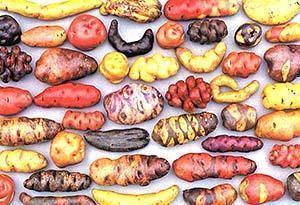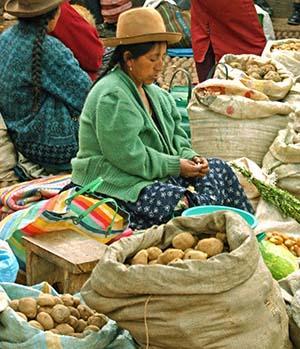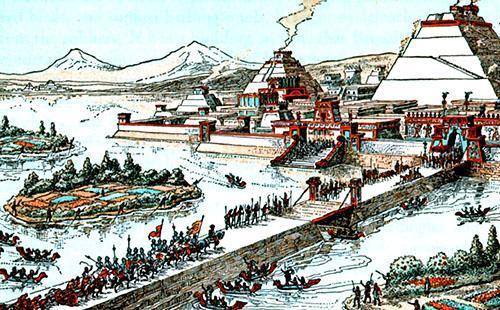European pages in the history of the potato
 The history of the spread of potatoes around the world began in the middle of the 16th century, when the Spanish conquistadors landed on the shores of modern Peru. The conquerors were attracted by the treasures of unknown countries. They did not even think that through the centuries the mention of their names would be associated not with victories in battles, but with the discovery and history of the potato, a modest plant from the Solanaceae family. Read:potato gratin - a step by step recipe with a photo.
The history of the spread of potatoes around the world began in the middle of the 16th century, when the Spanish conquistadors landed on the shores of modern Peru. The conquerors were attracted by the treasures of unknown countries. They did not even think that through the centuries the mention of their names would be associated not with victories in battles, but with the discovery and history of the potato, a modest plant from the Solanaceae family. Read:potato gratin - a step by step recipe with a photo.
South American origin of potatoes
More than 99% of today's seed potatoes share common genes. All cultivated varieties, one way or another, belong to two related species.

Today, numerous varieties of Solanum tuberosum or Nightshade tuberous are grown in most regions of the world. Potatoes became the main food and industrial crop for billions of people who sometimes do not know the origin of the potato.
Nevertheless, in the homeland of the culture, from 120 to 200 species of wild varieties still grow. These are exclusively endemic to the American continent, and most are not only not edible, but even poisonous due to the glycoalkaloids contained in the tubers.
A book history of the potato in the 16th century
The discovery of the potato dates back to the era of the great geographical discoveries and conquests. The first descriptions of tubers belonged to Europeans, members of military expeditions in 1536-1538.
 One of the companions of the conquistador Gonzalo de Quesada in the Peruvian village of Sorokota saw tubers similar to truffles known in the Old World or, as they were called "tartuffoli". Probably, this word became the prototype of the modern pronunciation of the German and Russian names. But the English-language version of "potato" is the result of a confusion between the tubers of a similar appearance to ordinary and sweet potatoes, which the Incas called "sweet potatoes".
One of the companions of the conquistador Gonzalo de Quesada in the Peruvian village of Sorokota saw tubers similar to truffles known in the Old World or, as they were called "tartuffoli". Probably, this word became the prototype of the modern pronunciation of the German and Russian names. But the English-language version of "potato" is the result of a confusion between the tubers of a similar appearance to ordinary and sweet potatoes, which the Incas called "sweet potatoes".
The second chronicler in the history of the potato was the naturalist and botanist-researcher Pedro Ciesa de Leon, who found fleshy tubers in the upper Cauca River that reminded him of chestnuts when cooked. Most likely, both travelers painted Andean potatoes.
Personal acquaintance and the fate of a garden flower
 Europeans, having heard about the extraordinary countries and their riches, could see the overseas plant with their own eyes only thirty years later. Moreover, the tubers that arrived in Spain and Italy were not from the mountainous regions of Peru, but from Chile, and belonged to a different type of plant. The new vegetable did not suit the taste of the European nobility and, as a curiosity, was settled in greenhouses and gardens.
Europeans, having heard about the extraordinary countries and their riches, could see the overseas plant with their own eyes only thirty years later. Moreover, the tubers that arrived in Spain and Italy were not from the mountainous regions of Peru, but from Chile, and belonged to a different type of plant. The new vegetable did not suit the taste of the European nobility and, as a curiosity, was settled in greenhouses and gardens.
Karl Kluzius played an important role in the history of the potato, at the end of the 16th century he founded the planting of this plant in Austria and then in Germany. After 20 years, potato bushes adorned the parks and gardens of Frankfurt am Main and other cities, but it was not soon to become a garden culture.
Only in Ireland, the potato introduced in 1587 quickly took root and began to play a significant role in the economy and life of the country, where the main sown area was always given to cereals. At the slightest crop failure, the population was threatened with a terrible famine. The unpretentious fruitful potatoes were very useful here.Already in the next century, the country's potato plantations could feed 500 thousand Irish.
 And in France and in the 17th century, potatoes had serious enemies, who considered tubers suitable for food only for the poor or even poisonous. In 1630, by parliamentary decree, the cultivation of potatoes in the country was prohibited, and Diderot and other enlightened people were on the side of the legislators. But still a man appeared in France who dared to stand up for the plant. Apothecary A.O., who was in Prussian captivity. Parmentier brought the tubers that saved him from hunger to Paris and decided to demonstrate their dignity to the French. He arranged a magnificent potato dinner for the color of the capital's society and the learned world.
And in France and in the 17th century, potatoes had serious enemies, who considered tubers suitable for food only for the poor or even poisonous. In 1630, by parliamentary decree, the cultivation of potatoes in the country was prohibited, and Diderot and other enlightened people were on the side of the legislators. But still a man appeared in France who dared to stand up for the plant. Apothecary A.O., who was in Prussian captivity. Parmentier brought the tubers that saved him from hunger to Paris and decided to demonstrate their dignity to the French. He arranged a magnificent potato dinner for the color of the capital's society and the learned world.
Long-awaited recognition by Europe and distribution in Russia
Only the Seven Years War, devastation and famine forced a change in attitudes towards the culture of the Old World. And this happened only in the middle of the 18th century. Thanks to the pressure and cunning of the Prussian king Frederick the Great, potato fields began to appear in Germany. The British, French and other, previously irreconcilable Europeans recognized the potatoes.
It was during these years that the Russian Count Sheremetyev received the first bag of precious tubers and a strict order to start growing. But such an imperial decree did not arouse enthusiasm in Russia.
 It would seem that the history of potatoes in this part of the world will not be smooth. Catherine II also promoted a new culture for the Russians and even started a plantation in the Pharmaceutical Garden, but ordinary peasants in every way resisted the plant planted from above. Until the 40s of the XIX century, potato riots thundered across the country, the reason for which was simple. The farmers who grew the potatoes left the harvest in the light. As a result, the tubers turned green and became unsuitable for food. The work of the whole season went down the drain, and discontent was ripening among the peasants. The government adopted a serious campaign to explain agricultural techniques and potato consumption. In Russia, with the development of industry, potatoes quickly became truly "second bread". Tubers were used not only for their own consumption and animal feed, they were used to produce alcohol, molasses, starch.
It would seem that the history of potatoes in this part of the world will not be smooth. Catherine II also promoted a new culture for the Russians and even started a plantation in the Pharmaceutical Garden, but ordinary peasants in every way resisted the plant planted from above. Until the 40s of the XIX century, potato riots thundered across the country, the reason for which was simple. The farmers who grew the potatoes left the harvest in the light. As a result, the tubers turned green and became unsuitable for food. The work of the whole season went down the drain, and discontent was ripening among the peasants. The government adopted a serious campaign to explain agricultural techniques and potato consumption. In Russia, with the development of industry, potatoes quickly became truly "second bread". Tubers were used not only for their own consumption and animal feed, they were used to produce alcohol, molasses, starch.
Irish Potato Tragedy
And in Ireland, potatoes have become not only a mass crop, but also a factor influencing fertility. The ability to feed families cheaply and satisfyingly has led to a sharp increase in the population of Ireland. Unfortunately, the addiction that arose in the first half of the 19th century led to disaster. An unexpected epidemic of phytophthora, which destroyed potato plantings in many regions of Europe, caused a terrible famine in Ireland, which halved the country's population.
 Some people died, and many were forced to go overseas in search of a better life. Together with the settlers, potato tubers also came to the shores of North America, giving rise to the first cultivated plantations on these lands and the history of potatoes in the USA and Canada. In Western Europe, phytophthora was defeated only in 1883, when an effective fungicide was found.
Some people died, and many were forced to go overseas in search of a better life. Together with the settlers, potato tubers also came to the shores of North America, giving rise to the first cultivated plantations on these lands and the history of potatoes in the USA and Canada. In Western Europe, phytophthora was defeated only in 1883, when an effective fungicide was found.
British colonists and the history of the Egyptian potato
 At the same time, European countries are beginning to actively expand potato cultivation to their colonies and protectorates. This culture came to Egypt and other countries of northern Africa at the beginning of the 19th century, but became widespread thanks to the British on the eve of the First World War. Egyptian potatoes were used to feed the army, but at that time the local peasants had neither experience nor sufficient knowledge to obtain serious harvests... Only in the last century, with the advent of the possibility of irrigating plantations and new varieties, potatoes began to give abundant harvests in Egypt and other countries.
At the same time, European countries are beginning to actively expand potato cultivation to their colonies and protectorates. This culture came to Egypt and other countries of northern Africa at the beginning of the 19th century, but became widespread thanks to the British on the eve of the First World War. Egyptian potatoes were used to feed the army, but at that time the local peasants had neither experience nor sufficient knowledge to obtain serious harvests... Only in the last century, with the advent of the possibility of irrigating plantations and new varieties, potatoes began to give abundant harvests in Egypt and other countries.
Indeed, modern tubers bear little resemblance to those that were once brought from South America. They are much larger, have a rounded shape and excellent taste.
 Today, potatoes are taken for granted in the diet of many peoples. People do not think or even do not know that the real acquaintance of mankind with this culture took place less than five hundred years ago. They don't know the origin of the potatoes on the plate. But until now, scientists are showing serious interest precisely in wild species that are not afraid of many diseases and pests of cultivated varieties. To preserve and study the still unexplored possibilities of the plant, specialized scientific institutes work around the world. In the homeland of culture, in Peru, the International Potato Center has created a repository of 13 thousand samples of seeds and tubers, which has become a gold fund for breeders around the world.
Today, potatoes are taken for granted in the diet of many peoples. People do not think or even do not know that the real acquaintance of mankind with this culture took place less than five hundred years ago. They don't know the origin of the potatoes on the plate. But until now, scientists are showing serious interest precisely in wild species that are not afraid of many diseases and pests of cultivated varieties. To preserve and study the still unexplored possibilities of the plant, specialized scientific institutes work around the world. In the homeland of culture, in Peru, the International Potato Center has created a repository of 13 thousand samples of seeds and tubers, which has become a gold fund for breeders around the world.